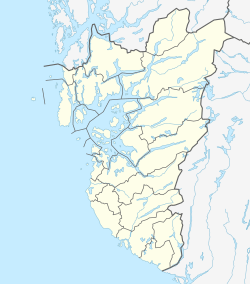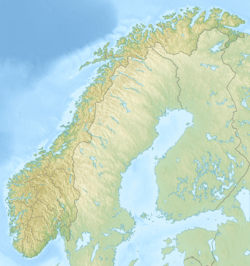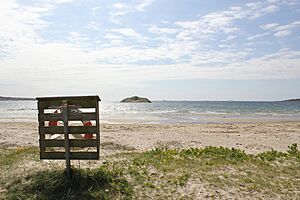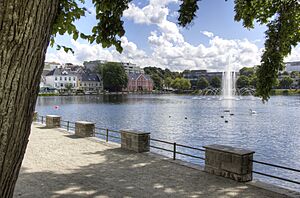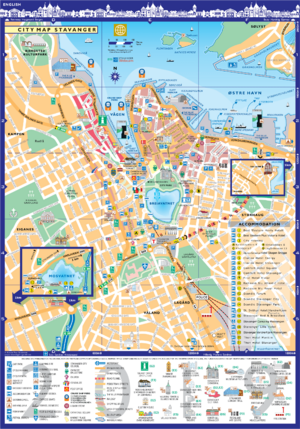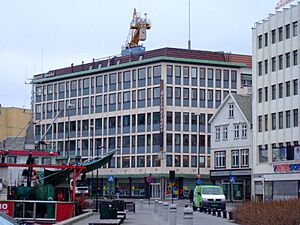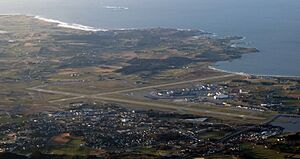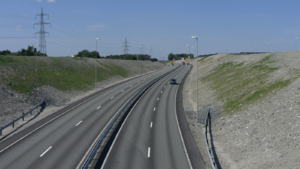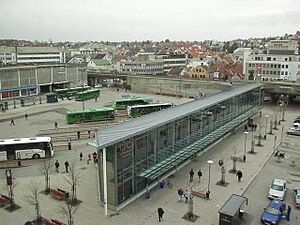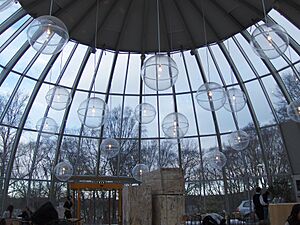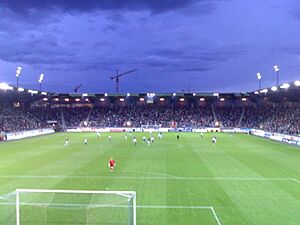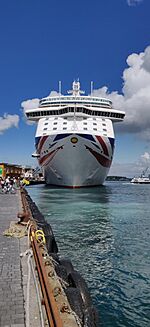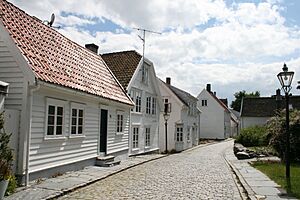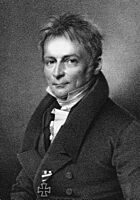Stavanger facts for kids
Quick facts for kids
Stavanger
Stavanger kommune
|
|||
|---|---|---|---|
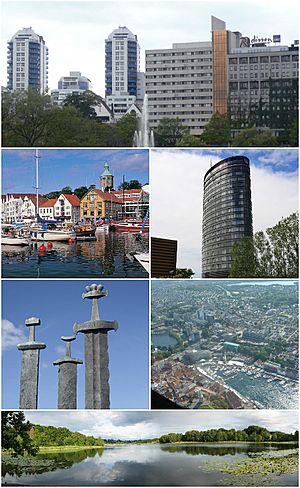
(top down, clockwise)
|
|||
|
|||
| Nickname(s):
Oljebyen, The oil capital
|
|||
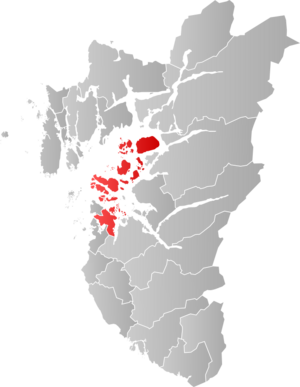 |
|||
| Country | |||
| Municipality | Stavanger | ||
| County | Rogaland | ||
| District | Jæren | ||
| Established | 1125 | ||
| Area | |||
| • Municipality | 71.35 km2 (27.55 sq mi) | ||
| • Urban | 77.98 km2 (30.11 sq mi) | ||
| • Metro | 2,598 km2 (1,003 sq mi) | ||
| Population
(2023)
|
|||
| • Municipality | 148,682 | ||
| • Density | 2,083.84/km2 (5,397.1/sq mi) | ||
| • Urban | 237,369 | ||
| • Urban density | 3,043.97/km2 (7,883.9/sq mi) | ||
| • Metro | 360,000 | ||
| • Metro density | 138.6/km2 (359/sq mi) | ||
| • Municipality/ Urban rank | 4th/3rd | ||
| • Metro rank | 3rd | ||
| Demonym(s) | Siddis | ||
| Nationalities | |||
| • Norwegians | 75% | ||
| • Other | 25% | ||
| GDP | |||
| • Metro | €31.582 billion (2021) | ||
| Time zone | UTC+01:00 (CET) | ||
| • Summer (DST) | UTC+02:00 (CEST) | ||
| Historical population | ||
|---|---|---|
| Year | Pop. | ±% |
| 1769 | 3,337 | — |
| 1951 | 50,617 | +1416.8% |
| 1960 | 52,835 | +4.4% |
| 1970 | 81,741 | +54.7% |
| 1980 | 89,913 | +10.0% |
| 1990 | 97,570 | +8.5% |
| 2000 | 108,818 | +11.5% |
| 2010 | 123,850 | +13.8% |
| Source: Statistics Norway | ||
Stavanger is a city and municipality in Norway. It is the third largest city and metropolitan area in Norway. Stavanger is the main city of Rogaland county. The city is located on the Stavanger Peninsula in southwest Norway. Stavanger was officially founded in 1125. This was the year the Stavanger Cathedral was finished.
Much of Stavanger's center has old wooden houses from the 18th and 19th centuries. These houses are protected as part of the city's history. This helps the city center keep its small-town feel. It also means many people live in separate houses. This has helped the city grow into areas around it, known as Greater Stavanger.
The city grew quickly in the late 1900s because of its oil industry. Today, Stavanger is known as Norway's "Oil Capital." Equinor, a big energy company, has its main office here. It is the largest company in the Nordic region. Stavanger also has several educational institutions for higher learning. The biggest is the University of Stavanger.
Stavanger is home to military bases, including the NATO Joint Warfare Centre. Many international companies, especially oil and gas firms, also have offices here. This means a lot of people from other countries live in Stavanger. The city has a strong international feel. About 22% of its population has an immigrant background. In 2020, it was named the best city in Norway for people from other European countries to live in. It was also ranked 5th best in Europe by ECA International.
Since the early 2000s, Stavanger has had very low unemployment. This rate is much lower than the average in Europe. In August 2022, only 1.6% of people were unemployed. The city is also known for being one of the most expensive cities in the world. Some studies have even called it the world's most expensive city.
The climate of Stavanger is very mild for a Nordic city. This is because it is close to the sea. Winters usually stay above freezing. Very hot weather is rare and does not last long. Rain is common, but less so than in areas further north along the coast.
Stavanger has an international airport, Stavanger Airport, Sola. It has flights to many major European cities. There are also some long-distance charter flights. In 2020, OAG said it was one of the most on-time airports in its size category.
Every two years, Stavanger hosts the Offshore Northern Seas (ONS). This is the second largest event for the energy industry. The Gladmat food festival happens every year. It is one of Scandinavia's top food festivals. Stavanger is also known for its great food scene. In 2008, Stavanger was a European Capital of Culture, along with Liverpool.
Contents
History of Stavanger

People first lived in the Stavanger area about 10,000 years ago. This was when the ice from the last ice age melted away. Many historians believe that North-Jæren was an important economic and military center. This was true as far back as the 800s and 900s. The country of Norway was formed after the Battle of Hafrsfjord around 872. Stavanger grew into a center for the church and a key market town on the southwest coast. This happened between 1100 and 1300.
Stavanger was already like a town before it officially became a city in 1125. This was around the 1120s when the Stavanger bishopric was set up. Bishop Reinald, possibly from England, started building Stavanger Cathedral around 1100. It was finished around 1125. This is why 1125 is considered the city's founding year.
After the Protestant Reformation in 1536, Stavanger's role as a church center became less important. When Kristiansand was founded in the early 1600s, the bishopric moved there. But in the 1800s, many herring fish were caught. This brought new life and growth to the city.
Stavanger became a municipality on January 1, 1838. Over the years, small areas from the nearby municipality of Hetland were added to Stavanger. This happened in 1867, 1879, 1906, 1923, and 1953. On January 1, 1965, Stavanger merged with Madla and most of Hetland. This made Stavanger a much larger municipality.
The city's history has seen many ups and downs in its economy. For a long time, its main industries were shipping, shipbuilding, and the fish canning industry.
In 1969, a new period of growth began. This was when oil was first found in the North Sea. After much talk, Stavanger was chosen as the main land base for Norway's oil industry. This led to a time of very fast growth for the city.
On January 1, 2020, the nearby municipalities of Finnøy and Rennesøy joined Stavanger. This created an even bigger municipality.
City Growth Over Time
Stavanger is one of Norway's oldest cities. It started to grow in the 1100s. This was a time when more people were living in cities across northern Europe. We do not have many old records about how the city first grew. So, there is much we do not know. But it was an important area from early on. Both the king and the church wanted a strong base in the South West coast area. In North Jæren, old findings show that local leaders had a lot of power. Stavanger had a natural harbor. It was also important for trade along the western coast. The fertile Ryfylke Islands to the north were also key.
The first Christian ideas came to Stavanger through trade with Europe and Great Britain. This happened during the Viking era. Around the mid-900s, old Norse burial customs stopped in Stavanger. At the same time, the first Christian priests began their work. Large stone crosses are still visible from this early Christian time. These include the Tjora and Kvitsøy crosses. A memorial cross for lendmann Erling Skjalgsson was put up near Stavanger. This was after he died in 1028. Erling controlled the southwest coast. The cross's location suggests he had a special link to Stavanger. The writing on the cross shows a priest made it. This priest might have held an early church service there.
Old buildings and the Cathedral crypt show that a big fire in 1272 destroyed much of the city. The fire also damaged the cathedral. After the fire, the cathedral was rebuilt. A new front was added. St. Mary's Church and the Bishop's Chapel were also built or rebuilt.
Stavanger has a long history of education. A monastery here first saw the need to teach new workers. The first organized teaching likely happened at a Benedictine monastery. This was around the mid-1100s.
A very important event was a gift letter from King Magnus Erlingsson. He gave it to Stavanger Bishop Eirik Ivarsson in the late 1100s. We do not know the exact date or reasons for this gift. It might have been in 1163–1164, when King Magnus was crowned. Or it could have been around 1181–1184. This was when Bishop Erik supported King Magnus against King Sverre.
Stavanger was clearly a church city throughout the Middle Ages. But the Reformation greatly affected the church and Stavanger. The cathedral, bishop, and monastery had owned much land. The city's economy declined as fewer people lived in rural areas. This meant less income for the church. In 1537, the king took over the church's land and property. In 1539, Kongsberg was robbed. St. Swithun's casket disappeared. Bishop Hoskuld Hoskuldsson may have been executed.
World War II in Stavanger
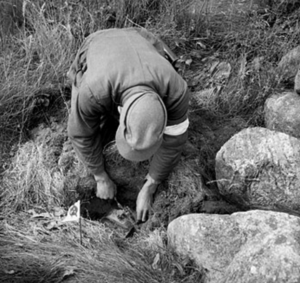
Before the main invasion, on April 8, 1940, a German ship named Roda anchored near Ulsnes. It was said to be carrying coke. But customs officers and police thought it might have other cargo. The ship was not sitting deep enough in the water. The Norwegian ship Æger was sent to investigate. Its captain, Niels Larsen Bruun, decided to sink the Roda. After the crew left, Æger fired 25 shots and sank the ship.
Early on April 9, 1940, explosions and bombs hit Sola. News on the radio announced the German attack on Norway. Sola Airport was the first target in North Jæren. Six German Messerschmitt Bf 110 planes attacked the airport around 8 am. The airport was built in 1937. In April 1940, its defenses were not ready. There was a concrete bunker still being built. There were also some open firing spots. The airport had three heavy anti-aircraft machine guns. It also had three heavy machine guns for ground targets. About 80 soldiers defended the airport. Some old planes took off shortly after the attack began.
The German air attack got stronger. The bombing lasted about an hour. Then, 10 slow Ju 52 transport planes arrived. They had flown from Hamburg. These planes dropped yellow containers with weapons and gear. Then, 10 to 12 paratroopers jumped from each plane. This was only the second time paratroopers were used in wartime. The first was just three hours earlier in Denmark. At Sola airport, the concrete bunker held out the longest. But it was eventually taken out with a hand grenade. Norwegian soldiers were hurt, but no one died. The Germans lost several soldiers. Lieutenant Thor Tang, who led the Norwegian defense, gave up at 10:00 am. The Germans immediately started landing troops, fuel, and other supplies. About 200 to 300 transport planes arrived that day. By evening, hundreds of soldiers and much equipment had moved from Germany to Sola.
Around 12:30 pm on April 9, German troops entered Stavanger without a fight. They took control of important places. These included the police station, telephone office, and port office. The city was taken without conflict. But some people started to resist. Several men left the city to join Norwegian troops in Gjesdal. They wanted to fight against the enemy.
The Germans wanted a good railway link between the air base at Sola-Stavanger and the rest of the country. But the Southern Railway was not finished until April 29, 1944. The Germans had hoped to finish it by November 1, 1941.
After Hitler died in 1945, Grand Admiral Karl Dönitz took charge of the German forces. On May 9, 1945, he ordered General Franz Böhme to surrender the German forces in Norway. About 15,000 German soldiers were in Rogaland in 1945. General Weckman, their commander, formally surrendered there.
Before going home, the Germans had to clean up after five years of occupation. There were 180 German minefields in Rogaland. They had 480,000 mines. The German army had to clear all of them. Sixty-two Germans died and 94 were hurt clearing mines in Rogaland. Even today, mines from this time are still found.
Oil Capital of Norway
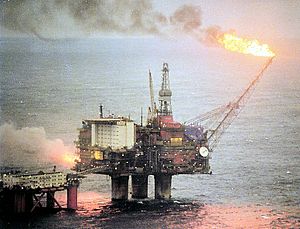
In 1969, a new period of growth began for Stavanger. This was when oil was first found in the North Sea.
After much discussion, Stavanger was chosen as the main land base for the oil industry. This was for the Norwegian part of the North Sea. A time of fast growth followed.
In March 1965, Norway and the United Kingdom agreed to share the continental shelf. A similar agreement was made with Denmark that same year. These agreements created rules for oil exploration. The first licenses to search for oil were given out on April 13, 1965. In August, the government gave 22 licenses for 78 areas to oil companies. These licenses gave companies the right to explore, drill, and produce oil in a certain area. Esso was the first oil company to start drilling off Norway's coast. The drilling ship Ocean Traveler came from New Orleans. It started drilling on July 19, 1966. This was about 180 kilometers southwest of Stavanger.
Stavanger's Coat of Arms
Hallvard Trætteberg, an expert in symbols, designed Stavanger's official coat of arms. He worked on it from the late 1920s until it was approved on August 11, 1939. His design is used for the city's arms, flag, and seal. The coat of arms is based on an old seal from 1591. It shows a branch of vine (Vitis vinifera). People have debated what kind of leaves and branch are shown. The original meaning of the vine is not known.
What's in a Name?
The old Norse name for Stavanger was Stafangr. People have discussed the name's meaning for many years. The most common idea is that it was the name of the inlet now called Vågen. This inlet was where the city first started.
The first part of the name, stafr, means 'staff' or 'branch'. This could describe the shape of the inlet. It could also refer to the mountain Valberget. Staven means 'the staff' and is a common name for tall, steep mountains in Norway. The last part, angr, means 'inlet' or 'bay'. Stavanger faces the North Sea. So, its economy has always depended on its access to the sea.
Geography of Stavanger
Stavanger is located in a coastal area. It borders the sea to the west and Boknafjorden to the northeast. The Byfjorden and Gandsfjorden are on the east side of the city. Stavanger is part of Low-Jæren. This is a flat area with mostly marsh, sand, and stone. It stretches from the Ogna River in the south to Tungenes in the north. Stavanger is in the northern part of this area. Most of the municipality is between 0 and 50 meters above sea level. The landscape has a unique look with rocks and hills where there are no buildings or farms. The city is very connected to the sea and water. It has five lakes, including Breiavatnet, Stora Stokkavatnet, and Mosvatnet. It also has three fjords: Hafrsfjorden, Byfjorden, and Gandsfjorden. The sea and water shape the land. They provide a coastline rich with plants and animals.
The land is mostly low. About 49% of the area is less than 20 meters above sea level. Only 7% of the land is at 60 meters. Stavanger's highest point is Bandåsen, which is 514 meters tall.
The city has grown on both sides of a valley. This valley runs through the land. It has steep slopes rising from the bottom. An arm of Boknafjorden and Byfjorden enters the harbor from the northwest. Hillevåg lake comes in from Gandsfjorden in the southeast. Breiavatnet is located between these two fjord arms.
The city includes many islands off the coast. These are Bjørnøy, Buøy, Engøy, Grasholmen, Hellesøy, Hundvåg, Kalvøy, Lindøy, Sølyst, and Vassøy. It also includes the eastern half of the island of Åmøy.
City Parks and Green Spaces
Stavanger has many parks and green areas. These are both in the city and outside it. In the city center is the city lake. Around it is the city park, which was built in 1866–1868. Between the city park and the bay is Kielland garden. It is named after the poet Alexander Kielland, whose house was once there. Kielland Park was greatly improved in 2007. At the other end of the city lake, near the station, is a small park. Here you can find the Emigration statue. It was a gift from Norwegian emigrants in the United States. It honors the Norwegians who helped build America.
Bjergstedparken is a park north of Old Stavanger. It is home to the Bjergsted Music Center, which includes Stavanger Concert Hall. Its outdoor areas are often used for festivals and concerts. The Missing park is on the west side of the harbor. It leads into the Old Town. Canon park is a border between Stavanger and the E39 highway. Kannik creek runs through this park. It flows into Breiavannet.
Outside the city center, there are parks near large inland lakes. These include Mosvatnet, Stora Stokkavatnet, and Water Assen. Mosvatnet is 0.46 square kilometers. It is the third largest lake in Stavanger. It supplied the city's drinking water from 1863 to 1931. Now, it is the most used recreation area in Stavanger. The path around the lake is 3.2 kilometers long. Many cyclists and joggers use it. In 1995, it was estimated that 560,000 people used the path. At the south end are Mosvangen Camping and Vålandskogen. To the west is Rogaland Kunstmuseum. Stora Stokkavatnet is 2.19 square kilometers. It is the largest lake in Stavanger. The hiking trail around it is 8.2 kilometers long. There is a small island in the lake called Storeholmen. Stora Stokkavatnet provided drinking water from 1931 to 1959. Now, it is legal to swim in the water.
Stavanger's Climate
Stavanger is on Norway's southwest coast. Its climate is greatly affected by the warm water in the North Sea. Winds from the Atlantic also bring mild weather, even in winter. This means temperatures are warmer all year compared to other cities at the same latitude. It also brings a lot of rain, especially in late autumn and winter.
Stavanger has a temperate oceanic climate. This means five months have an average temperature above 10°C. Spring and early summer are the driest times. The hottest temperature ever recorded at the airport was 33.5°C in August 1975. The warmest high in Stavanger was 34.4°C in July 2018. The warmest month on record at Stavanger Airport was August 2002. Its average temperature was 19.3°C. The coldest temperature ever recorded was -19.8°C in January 1987. The coldest month on record was February 1963. Its average temperature was -5°C. The last night freeze in spring is usually around April 20. The first freeze in autumn is around October 31. This gives Stavanger a frost-free season of 193 days.
| Climate data for Stavanger Airport Sola 1991–2020 (7 m, extremes 1947–present, sunhours 1961–1990) | |||||||||||||
|---|---|---|---|---|---|---|---|---|---|---|---|---|---|
| Month | Jan | Feb | Mar | Apr | May | Jun | Jul | Aug | Sep | Oct | Nov | Dec | Year |
| Record high °C (°F) | 12.4 (54.3) |
13.9 (57.0) |
17.7 (63.9) |
25.2 (77.4) |
29.4 (84.9) |
30.5 (86.9) |
32.5 (90.5) |
33.5 (92.3) |
29.3 (84.7) |
22.3 (72.1) |
16.2 (61.2) |
12 (54) |
33.5 (92.3) |
| Mean daily maximum °C (°F) | 4.8 (40.6) |
4.6 (40.3) |
6.5 (43.7) |
10.4 (50.7) |
13.8 (56.8) |
16.3 (61.3) |
18.6 (65.5) |
19 (66) |
16.1 (61.0) |
11.9 (53.4) |
8 (46) |
5.6 (42.1) |
11.3 (52.3) |
| Daily mean °C (°F) | 2.6 (36.7) |
2.1 (35.8) |
3.7 (38.7) |
6.9 (44.4) |
10.2 (50.4) |
13 (55) |
15.3 (59.5) |
15.7 (60.3) |
13.2 (55.8) |
9.2 (48.6) |
5.7 (42.3) |
3.4 (38.1) |
8.4 (47.1) |
| Mean daily minimum °C (°F) | 0 (32) |
−0.4 (31.3) |
0.9 (33.6) |
3.6 (38.5) |
6.8 (44.2) |
9.9 (49.8) |
12.4 (54.3) |
12.7 (54.9) |
10.3 (50.5) |
6.4 (43.5) |
3 (37) |
0.6 (33.1) |
5.5 (41.9) |
| Record low °C (°F) | −19.8 (−3.6) |
−19.2 (−2.6) |
−16.2 (2.8) |
−7.9 (17.8) |
−2.5 (27.5) |
0.6 (33.1) |
4.3 (39.7) |
1.2 (34.2) |
−2.5 (27.5) |
−5.2 (22.6) |
−16.1 (3.0) |
−16.1 (3.0) |
−19.8 (−3.6) |
| Average precipitation mm (inches) | 118.5 (4.67) |
99.6 (3.92) |
80.5 (3.17) |
62.5 (2.46) |
62.1 (2.44) |
67.3 (2.65) |
91.2 (3.59) |
126.5 (4.98) |
132 (5.2) |
148.3 (5.84) |
135.2 (5.32) |
132.4 (5.21) |
1,256.1 (49.45) |
| Average precipitation days (≥ 1.0 mm) | 16 | 14 | 13 | 11 | 10 | 10 | 12 | 14 | 15 | 17 | 16 | 17 | 165 |
| Average relative humidity (%) | 82 | 81 | 78 | 77 | 75 | 78 | 78 | 80 | 80 | 81 | 82 | 82 | 80 |
| Mean monthly sunshine hours | 48 | 79 | 140 | 168 | 226 | 222 | 197 | 159 | 141 | 80 | 45 | 33 | 1,538 |
| Source 1: yr.no/met.no NOAA (humidity) | |||||||||||||
| Source 2: NOAA - WMO averages 91-2020 Norway | |||||||||||||
| Climate data for Stavanger Airport (2002–2020 averages & extremes) | |||||||||||||
|---|---|---|---|---|---|---|---|---|---|---|---|---|---|
| Month | Jan | Feb | Mar | Apr | May | Jun | Jul | Aug | Sep | Oct | Nov | Dec | Year |
| Record high °C (°F) | 11.2 (52.2) |
13.9 (57.0) |
17.7 (63.9) |
22.4 (72.3) |
29.4 (84.9) |
29.1 (84.4) |
32.5 (90.5) |
29.4 (84.9) |
26.7 (80.1) |
22.3 (72.1) |
16.2 (61.2) |
12.0 (53.6) |
32.5 (90.5) |
| Mean maximum °C (°F) | 9.0 (48.2) |
8.9 (48.0) |
12.1 (53.8) |
17.4 (63.3) |
22.9 (73.2) |
24.8 (76.6) |
26.7 (80.1) |
25.7 (78.3) |
21.6 (70.9) |
16.9 (62.4) |
12.8 (55.0) |
9.9 (49.8) |
28.2 (82.8) |
| Mean daily maximum °C (°F) | 4.7 (40.5) |
4.8 (40.6) |
6.8 (44.2) |
10.9 (51.6) |
13.9 (57.0) |
16.8 (62.2) |
19.0 (66.2) |
19.2 (66.6) |
16.4 (61.5) |
12.2 (54.0) |
8.4 (47.1) |
6.0 (42.8) |
11.6 (52.9) |
| Daily mean °C (°F) | 2.3 (36.1) |
2.3 (36.1) |
3.9 (39.0) |
7.5 (45.5) |
10.5 (50.9) |
13.6 (56.5) |
15.9 (60.6) |
16.1 (61.0) |
13.5 (56.3) |
9.3 (48.7) |
5.8 (42.4) |
3.6 (38.5) |
8.7 (47.6) |
| Mean daily minimum °C (°F) | −0.2 (31.6) |
−0.3 (31.5) |
1.0 (33.8) |
4.0 (39.2) |
7.1 (44.8) |
10.3 (50.5) |
12.8 (55.0) |
12.9 (55.2) |
10.6 (51.1) |
6.4 (43.5) |
3.2 (37.8) |
1.1 (34.0) |
5.7 (42.3) |
| Mean minimum °C (°F) | −8.9 (16.0) |
−7.5 (18.5) |
−5.5 (22.1) |
−1.4 (29.5) |
1.8 (35.2) |
6.0 (42.8) |
8.8 (47.8) |
8.1 (46.6) |
5.2 (41.4) |
−0.6 (30.9) |
−4.9 (23.2) |
−6.8 (19.8) |
−10.9 (12.4) |
| Record low °C (°F) | −19.1 (−2.4) |
−12.8 (9.0) |
−13.3 (8.1) |
−5.2 (22.6) |
−1.5 (29.3) |
3.9 (39.0) |
6.6 (43.9) |
6.0 (42.8) |
1.8 (35.2) |
−4.3 (24.3) |
−11.7 (10.9) |
−15.5 (4.1) |
−19.1 (−2.4) |
| Average precipitation mm (inches) | 122.5 (4.82) |
89.6 (3.53) |
72.9 (2.87) |
60.7 (2.39) |
69.0 (2.72) |
66.9 (2.63) |
104.0 (4.09) |
131.3 (5.17) |
146.0 (5.75) |
142.5 (5.61) |
141.6 (5.57) |
134.6 (5.30) |
1,281.6 (50.45) |
| Source: Norsk Klimaservicesenter | |||||||||||||
Stavanger's Boroughs and Neighborhoods
Stavanger is officially divided into 22 main parts and 218 smaller parts. It is also split into seven larger areas called boroughs.
- Hundvåg
- Tasta
- Eiganes og Våland
- Madla
- Storhaug
- Hillevåg
- Hinna
Local Neighborhoods
Some of the neighborhoods in Stavanger include:
- Byhaugen
- Old Stavanger
- Bekkefaret
- Bergjeland
- Eiganes
- Forus
- Gausel
- Godeset
- Indre Tasta
- Jåtten
- Johannes
- Kampen
- Kvalaberg
- Kvernevik
- Madlamark
- Nylund
- Øyane
- Paradis
- Stokka
- Sunde
- Tjensvoll
- Ullandhaug
- Våland
- Varden
- Vaulen
- Ytre Tasta
- Madla.
Stavanger's Economy
In the early 1900s, Stavanger's economy was mostly about fishing and shipping. In the first half of the century, it was famous for canning fish. By the 1950s, there were over 50 canning factories in the city. Stavanger was even called Norway's "canned capital." The last of these factories closed in 2002.
Around 1950, more than half of the city's workers were in industry. But changes in industry and the growth of service jobs have changed the city's economy a lot. Now, the service industry provides over 11% of jobs. However, the city still has 29% of the county's industrial jobs.
Engineering is now the main industry. It accounts for 59% of manufacturing jobs. This is mostly linked to the offshore oil industry. Building oil platforms alone makes up 40% of this. Other important industries are publishing, especially printing and newspapers like Stavanger Aftenblad. Food and drink production is also key. This includes processing local farm products from Jæren.
In 2007, 0.6% of jobs were in farming, 27.4% in manufacturing, and 71.7% in services. The public sector had 24.4% of jobs, while the private sector had 75.6%.
Industry has spread out in recent years. Important new industrial areas are Forus in the south, near Sandnes and Sola. Dusavik in the north focuses on oil-related work. Older industrial areas include Hillevåg, Buøy, and other coastal spots. Shipbuilding and shipping have also been very important for the city's growth. Rosenberg Shipyard, started in 1896, is on Hundvåg. Today, Stavanger is one of Norway's most important maritime cities. It ranks fourth for registered ships.
For four years in a row, the Stavanger Region was named the best business region in 2007. This ranking looked at how profitable, growing, and new businesses were.
Media in Stavanger
The city's largest daily newspaper is Stavanger Aftenblad. Its first issue came out in 1893. Its competitor, Rogalands Avis, started in 1899. It was first called 1ste Mai ('1 May'). In 1987, a new daily newspaper, The West Coast, tried to start. But it only lasted two months and lost a lot of money.
The first newspaper in Stavanger was handwritten. It was called "Stavangerske Adressecontoirs Efterretninger." It probably came out in 1769 and 1770. This was not a regular newspaper. It was for announcements, small articles, and ads. The first printed newspaper was "Stavanger Addresseavis." Its first issue was on October 4, 1833.
Stavanger Avis was published from 1888 to 1911. The writer Alexander Kielland was its editor in 1889. "Stavanger Avis" was also the name of a newspaper published from 1942 to 1945. This happened when Stavanger Aftenblad and Stavangeren were combined by the government.
The student newspaper SMiS (Studentmediene i Stavanger) comes out every other month.
Stavanger has one main TV station, TV Vest. It broadcasts local news and reports. Also, Viking TV, for the football team Viking FK, started on March 2, 2008. It reaches 120,000 viewers. NRK Rogaland provides local news on radio and TV. Local radio stations also offer local news.
Food and Farming
The Stavanger region is often called Norway's version of the French food region of Lyon. The Culinary Institute, located in Ullandhaug, used to focus heavily on food in Stavanger. After it faced financial issues in 2008, a new food organization was created. This new institute, also called The Culinary Institute, continued some of the original work.
In summer 2007, the region's food businesses were named "Norwegian Centers of Expertise in Culinology." A new building in Ullandhaug will be a place for new ideas in food research and development. In July 2008, Stavanger qualified for the Bocuse d'Or European championship. In 2008, Norway won gold with Geir Skeie. Every year, there is a "Happy Food Festival" in the city center. This festival started to share the food traditions of Rogaland county. By 2020, the Stavanger region aimed to be the region most Norwegians think of for food.
Oil Industry in Stavanger
In recent times, Stavanger has been called the "oil capital." Norway's largest oil company, Equinor, is based at Forus in Stavanger. Equinor (then called Statoil) was started by the Government of Norway on July 14, 1972. This was to help Norway take part in the oil industry. It also aimed to build Norwegian knowledge in oil and create a local oil industry. Placing Equinor's headquarters in Stavanger made the city the center of the oil industry. Petoro, a state-owned company that manages Norway's oil interests, also has its main office in Stavanger. Because the national oil industry is centered here, many other international oil companies have also set up their main offices in Stavanger.
The Norwegian Petroleum Directorate (NPD) was created in 1972. The Petroleum Safety Authority (PSA) was set up on January 1, 2004, next to the NPD. It acts as a safety watchdog.
Jåttåvågen, on Gandsfjorden, was a large industrial area from the 1970s to the 1990s. It was especially used for building huge concrete platforms for the offshore oil industry. For example, the bases for the Gullfaks platforms and Troll A were built here.
Offshore Northern Seas (ONS) is the second largest exhibition for the oil and gas industry. ONS takes place in Stavanger every other year in late August. In 2008, 38,000 people visited, with half coming from other countries.
Getting Around Stavanger
Stavanger Airport
Stavanger Airport, Sola, is in Sola. It is about 14 minutes from Stavanger city center. The airport opened in 1937. In 2013, Sola airport had over 4 million passengers. It was the largest airport in Rogaland county. It is also the 3rd largest airport in Norway and 7th in the Nordic countries. The busiest flight route is to Oslo-Gardermoen, with over 1.5 million passengers. The second busiest is to Bergen Airport, Flesland, with over 700,000 passengers. Other popular domestic routes include Oslo-Torp, Trondheim Airport, Værnes, and Kristiansand Airport, Kjevik. For international flights, the busiest routes are to Copenhagen, Amsterdam, and Aberdeen. Stavanger also has flights to other European cities like London, Paris, Barcelona, Stockholm, and Warsaw. Domestic flights go all the way from Tromsø to Kristiansand.
Train Travel
Stavanger Station opened in 1878. It is the end point for both the Sørlandet Line and the Jæren Line.
The Southern Railway runs from Oslo Central Station to Drammen, then to Kristiansand Station, and finally to Stavanger Station. This route is 545 kilometers long. It takes about seven hours and runs four times a day. The railway was built in stages. The first part opened in 1871, and the last part in 1944.
There are also local trains in Jæren with 19 stops on one line. This line opened in 1878. It was extended to Flekkefjord in 1904. A branch line to Ålgård opened in 1924. In 1944, the Sørlandet Line reached Sira. The Jæren Line then became part of the main railway network.
Roads and Tunnels
European route E39 passes through Stavanger. It uses the Mastrafjord Tunnel and Byfjord Tunnel. Then it goes south to Sandnes. Fylkesvei 44 starts in Stavanger and ends in Kristiansand. It passes through Sandnes and Flekkefjord.
National road 509 runs from Tasta Borough through Tananger, Sola, Stavanger Airport, and Forus. It ends at E39 near Jåtten.
On December 18, 2012, the new Solasplitten road opened. It is a new main road going east, north of Forus and the European route E39.
An undersea road tunnel connects Stavanger to Strand. This is part of the Ryfast tunnel link, which includes the Ryfylke Tunnel and Hundvåg Tunnel.
As of 2021, the Rogfast undersea road tunnel is being built. It will make travel between Stavanger and Haugesund easier.
Sea Travel
Outside Stavanger, there is a port for ferries to Hirtshals, Denmark. Some people want the Smyril Line ferry, which goes between the Faroe Islands and Denmark, to stop in Stavanger. The new port in Risavika makes this possible. It would only add one hour to the trip.
Local ferries go to Tau and Kvitsøy. Fast passenger boats go to many villages and islands. These are along the main routes from Stavanger to Haugesund and Sauda.
There are plans to restart the ferry link to Newcastle in the United Kingdom. This service stopped in 2008.
Bus Services
The local bus service in Stavanger is run by Rogaland Kollektivtrafikk (RKT). Their brand name is "Kolumbus". Boreal Transport operates the buses. RKT manages all bus routes in Rogaland County.
Express bus services are run by NOR-WAY Bussekspress. They go from Stavanger City Terminal to Kristiansand, Bergen, and Haugesund. Lavprisekspressen runs buses to Oslo via Kristiansand.
The city has many bus services and taxis.
Education in Stavanger
University of Stavanger (UIS) became Norway's fifth university on October 29, 2004. It was previously a college. The university has about 9,000 students and 1,200 staff. It has three main areas of study: Humanities, Social Sciences, and Science. The archaeological museum is also part of the university. Most departments are on the Ullandhaug campus. The University of Stavanger joined the European Consortium of Innovative Universities (ECIU) in October 2012.
The VID Specialized University has a long history in the city. It started as the School of Mission and Theology (MHS) in 1843. It became a research university in 2008. It has about 300 students from 20 countries. MHS is owned by the Norwegian Missionary Society. In 2016, it became part of the VID Specialized University.
The Art School in Rogaland was founded in 1978. Its history goes back to 1957.
The Scandinavian School of Management offers college studies in Marketing and Management.
Solborgveien Folk High School welcomes over 140 students each year. It is owned by the Lutheran church.
Other private schools include the International School of Stavanger, The British International School of Stavanger, and Stavanger French school.
High schools in Stavanger are part of Rogaland county. Specific schools in Stavanger include St. Olav, St. Svithun, Stavanger Cathedral School, Hetland, Jåttå, Stavanger Offshore Technical College, Godalen, and Bergeland.
Culture in Stavanger
Museums to Explore
Stavanger has several museums and collections. These are both local and national. The most visited museum is the Norwegian Petroleum Museum. It opened in 1998. From 1998 to 2008, almost 95,000 people visited it each year.
The city's oldest museum is Missjonmuseet. It was started in 1864. It is on the ground floor of the MHS faculty building. The museum has about 5,000 items. These include objects of cultural and historical interest from different mission fields.
Stavanger Museum was founded in 1877. It is one of the oldest museums. It includes several historic buildings and collections. Stavanger Museum has eight buildings in total: Stavanger Museum Muségata 16, Stavanger Maritime Museum, the Norwegian Canning Museum, Ledaal, Breidablikkveien museum, combined indretning, Norwegian Printing Museum, and the Norwegian Children's Museum. The main museum has a cultural department, animal collection, and a library.
The Museum of Archaeology in Stavanger is the largest museum by staff numbers. It is a state museum for prehistoric sites in Rogaland. It is part of the University of Stavanger. The museum also does a lot of public outreach. It is located near Stavanger Museum.
Rogaland Art Museum is by a park. It has paintings by Norwegian artists like Edvard Munch, Christian Krogh, and Harriet Backer. It also has the largest collection of Lars Hertervig's work. Other artists from Rogaland shown here include Kitty Kielland and Olaf Lange.
Vestlandske School Museum (Western Norway School Museum) is in Stavanger. It is in the old 1920 Kvaleberg school building. Started in 1925, it is a museum about school history in Rogaland.
Near the bay, you can find the Norwegian Emigration Center on the west side. On the eastern side of the bay is Valbergtårnet with its Watchmen's Museum. The Norwegian Telecom Museum has an office in Stavanger.
Churches in Stavanger
The Church of Norway has two main church districts in Stavanger. These are the Stavanger arch-deanery and the Ytre Stavanger deanery. These two districts are divided into 17 local church areas. All of them are part of the Diocese of Stavanger.
| Deanery (Prosti) | Parish (Sokn) | Church Name | Location of the Church | Year Built |
|---|---|---|---|---|
| Stavanger domprosti |
Stavanger domkirke | Stavanger Cathedral | Storhaug | 1150 |
| Bekkefaret | Bekkefaret Church | Bekkefaret | 1977 | |
| Hundvåg | Hundvåg Church | Hundvåg | 1983 | |
| Kampen | Kampen Church | Eiganes og Våland | 1957 | |
| St. Petri | St. Petri Church | Storhaug | 1866 | |
| St. Johannes | Frue Church | Storhaug | 1854 | |
| St. Johannes Church | Johannes | 1909 | ||
| Stokka | Stokka Church | Stokka | 1974 | |
| Tjensvoll | Tjensvoll Church | Tjensvoll | 1978 | |
| Varden | Varden Church | Varden | 1967 | |
| Ytre Stavanger prosti |
Gausel | Gausel Church | Gausel | 1996 |
| Hafrsfjord | Revheim Church | Kvernevik | 1865 | |
| Hillevåg | Hillevåg Church | Hillevåg | 1961 | |
| Hinna | Hinna Church | Hinna | 1967 | |
| Madlamark | Madlamark Church | Madlamark | 1976 | |
| Sunde | Sunde Church | Sunde | 1984 | |
| Tasta | Tasta Church | Indre Tasta | 1977 | |
| Vardeneset | Vardeneset Church | Ytre Tasta | 2000 | |
| Austre Åmøy Chapel | Austre Åmøy | 1904 |
Film and TV from Stavanger
Local Filmmaking
South West Film Forum started in 1992. It is an organization for film workers in Rogaland. Its goal is to improve the skills of film workers and encourage more filmmaking. The Film Forum Southwest has received support from the City of Stavanger since 1995.
Stavanger has given grants to support local filmmaking since 1997. The goal is to help the local film community grow. It also helps local filmmakers start projects that can get funding from other agencies. They also support finished projects, mainly to help cinemas show local films.
The movie Mongoland became a Norwegian film success. It was made outside the usual system for Norwegian film. This led to the creation of South West Film and Film Kraft Rogaland. These groups help provide long-term funding for film productions. Arild Østin Ommundsen directed Mongoland in 2000. He has since directed and written other films. Ommundsen helped start a new wave of filmmaking in Stavanger after Mongoland. Many actors from that film have become very successful.
Stian Kristiansen, from Stavanger, acted in "Mongoland." He later directed the film The Man Who Loved Yngve. This movie came out on February 15, 2008. The film received high praise in Norwegian media. Over 30,000 people watched it during its first weekend. In 2008, Kristiansen received a screenplay scholarship from Stavanger.
On September 30, 2010, the film Nokas premiered in Stavanger. It was directed by Erik Skjoldbjærg. The film is about the NOKAS robbery in Stavanger on April 5, 2004. It was filmed in the real locations where the event happened.
TV Series from Stavanger
Lykkeland ("State of Happiness") is a Norwegian drama series. It has 16 episodes in two seasons. The first season premiered on NRK1 in 2018. The series shows when Norway entered the oil age. It follows families and people in Stavanger. They experience big changes as the city shifts from fishing and farming to an international oil city. The second season premiered on January 2, 2022. It covers events in the 1970s and 1980s.
The series won two awards at the CannesSeries Festival in Cannes in 2018. The first season won five awards at the Gullruten ("Golden Screen," Norway) in 2019. These included best drama series and best actress. The second season won five awards at the Gullruten 2022.
Stavanger as European Capital of Culture 2008
Stavanger and its region, along with Liverpool, UK, were chosen as a European Capital of Culture for 2008. The idea behind Stavanger2008 was "Open Port." This means both "an open harbor" and "an open gate." It suggests being open to the world. The region and its people were meant to be more open to art, ideas, and opportunities.
Stavanger hosted the Cutty Sark Tall Ships' Race in 1997 and 2004.
Sports and Fun Activities
The biggest local football club in Stavanger is Viking FK. It is one of Norway's most successful football clubs. It has won eight league titles and five Norwegian Football Cup titles. The club plays its home matches at SR-Bank Arena, which opened in 2004.
After a short time in the second-tier league in 2018, Viking FK was promoted back to the top league, Eliteserien. It is now the club with the most seasons at the highest level of Norwegian football.
FK Vidar, another local football club, plays in the Norwegian second division.
Stavanger Oilers is the only team from western Norway in the top Norwegian ice hockey league, Fjordkraftligaen. It has won seven Norwegian championship titles. The club plays its home matches at DNB Arena, which opened in 2012.
The handball team Stavanger Håndball plays in the Norwegian second division.
Stavanger hosted the 2009 beach volleyball SWATCH FIVB World Championships.
The Sørmarka Arena is an indoor ice rink. It is used for national and international ice speed skating competitions.
| Club | Sport | Founded | League | Venue | Head coach(es) |
|---|---|---|---|---|---|
| Viking FK | Football | 1899 | Eliteserien | SR-Bank Arena | Bjarte Lunde Aarsheim Morten Jensen |
| Stavanger Oilers | Ice hockey | 2000 | Fjordkraftligaen | DNB Arena | Todd Bjorkstrand |
Music Scene
Every May, Stavanger hosts MaiJazz, the Stavanger International Jazz Festival. The International Chamber Music Festival takes place every August.
Stavanger is home to the Stavanger Symphony Orchestra (SSO). It is also home to gothic metal bands like Theatre of Tragedy, Tristania, and Sirenia. The singer Liv Kristine is also from here. The black metal band Gehenna is from Stavanger too. Janove Ottesen and Geir Zahl, who started the band Kaizers Orchestra, live in Stavanger. Other well-known artists from Stavanger include Kvelertak, Thomas Dybdahl, and Sturle Dagsland.
Community Art
Every September, Stavanger hosts the NuArt Festival. This festival shows off unique artists and performers from Norway and other countries. It has been called "one of Europe's most dynamic public art events."
Tourism in Stavanger
Stavanger is a popular place for tourists, especially in summer. Hotels in the city are often full all year. This is because many people travel to Stavanger for work and meetings. Recently, Stavanger has also become a very popular stop for cruise ships. The number of cruise ships visiting is growing steadily. This makes Stavanger one of Europe's fastest-growing cruise ports north of the Mediterranean.
In summer, Stavanger's harbor is full of large cruise ships. In 2011, Stavanger hosted 130 cruise ships. The Port of Stavanger is a popular stop on the way to the Norwegian Fjords. The charming city center is just a short walk from the dock.
Outdoor Adventures Nearby
There are not many outdoor activities right in Stavanger. However, there are great opportunities nearby in other towns. Lysefjorden is very popular for hiking. Tourists often visit places like Preikestolen (also known as the Pulpit Rock) and Kjeragbolten. Preikestolen is a huge rock hanging over the fjord, 604 meters below. Kjeragbolten is a rock stuck in the cliff about 1,000 meters above the fjord. The 1,000-meter drop to the fjord makes Kjerag a popular spot for BASE jumping.
Not far from Stavanger, there are places for skiing and snowboarding in winter.
Along the coast south of Stavanger, there are many large, sandy beaches. These include the beaches at Sola, which are close to the city.
Stavanger City Center
Old Stavanger (Gamle Stavanger) is right next to the city center. It has many wooden buildings from the 18th and 19th centuries.
Stavanger domkirke (St. Swithun's cathedral) was built between 1100 and 1150. It was built in an Anglo-Norman style. In the late 1200s, a new choir was added in Gothic style, with a vaulted roof. This cathedral is the only one in Norway that has stayed almost the same since the 1300s.
The city center itself is small and cozy. It has narrow streets and open areas where cars are not allowed.
Notable People from Stavanger
Public Service & Business Leaders
- Just Henrik Ely (1759–1824), military officer, represented at Norwegian Constitutional Assembly
- Gabriel Schanche Kielland (1760–1821), businessman and ship owner
- Peder Valentin Rosenkilde (1772–1836), merchant and representative at Norwegian Constituent Assembly
- Henrik Steffens (1773–1845), Norwegian philosopher, scientist, and poet
- Lars Oftedal (1838–1900), priest, social reformer, politician; founded Stavanger Aftenblad
- Christian Lous Lange (1869–1938), historian & political scientist; supported internationalism
- Jacob Christian Petersen (1870–1964), priest, first modern-day Bishop of Stavanger in 1925–1940
- Nicolai Rygg (1872–1957), economist and Governor of the Central Bank of Norway
- Olaf Gjerløw (1885–1949), newspaper editor, edited Morgenbladet in 1920–1949
- Thore Horve (1899–1990), naval officer, led the Royal Norwegian Navy in 1946–1949
- Håkon Nilsen (1913–1976), highly decorated war veteran of World War II, torpedo commander HNorMs Stord
- Ingerid Gjøstein Resi (1901–1955), language expert, women's rights leader and politician
- Sven Oftedal (1905–1948), doctor, politician and government minister
- Guri Hjeltnes (born 1953), journalist, historian and professor
- Anne Lise Ådnøy (born 1957), church leader, Bishop of Stavanger since 2019
- Leif Johan Sevland (born 1961), politician, Mayor of Stavanger from 1995 to 2011
- Aslak Sira Myhre (born 1973), journalist, director of the National Library of Norway since 2014
- Afua Hirsch (born 1981), British journalist, broadcaster and former lawyer
Artists and Performers
- Alexander Kielland (1849–1906), realistic writer, one of "The Four Greats"
- Peder Severin Krøyer (1851–1909), one of the Skagen Painters
- Frida Hansen (1855–1931), textile artist
- Olaf Lange (1875–1965), painter
- Henny Skjønberg (1886–1973), actress and stage director
- Fartein Valen (1887–1952), composer
- Henrik Grevenor (1896–1937), art historian and professor
- Liv Bredal (1919–2011), film actress
- Gunnar Eide (1920–2012), actor and theatre director
- Gunnar Bull Gundersen (1929–1993), sailor, novelist, playwright and lyricist
- Knut Husebø (born 1946), actor and visual artist
- Frode Gjerstad (born 1948), jazz musician, plays alto saxophone
- Ståle Kleiberg (born 1958), contemporary classical composer and music expert
- Mia Gundersen (born 1961), singer and actress
- Sigvart Dagsland (born 1963), singer, pianist, and composer
- Sveinung Bjelland (born 1970), classical pianist, soloist and Lieder accompanist
- Hans-Peter Lindstrøm (born 1973), multi-instrumentalist, DJ, and producer
- John Erik Kaada (born 1975), singer-songwriter, film score composer, multi-instrumentalist
- Liv Kristine Espenæs (born 1976) and Carmen Elise Espenæs, metal singer-songwriters
- Pia Tjelta (born 1977), Norwegian actress
- Johan Harstad (born 1979), novelist, short story writer, playwright and graphic designer
- Pål Sverre Hagen (born 1980), Norwegian stage and screen actor
- Ingrid Dahle (born c. 1990), comedian and actress
- Aurora (born 1996), singer, songwriter and record producer
Sports Stars
- Kjell Schou-Andreassen (1940–1997), football manager
- Svein Kvia (1947–2005), footballer
- Erik Thorstvedt (born 1962), footballer
- Asle Andersen (born 1972), football manager and player
- Gunn-Rita Dahle Flesjå (born 1973), cross-country mountain biker
- Cecilie Drabsch Norland (born 1978), Paralympic swimmer
- Linda Grubben (born 1979), biathlete
- Ane Stangeland Horpestad (born 1980), footballer
- Ole Erevik (born 1981), handball player
- Brede Hangeland (born 1981), footballer
- Kjetil Jansrud (born 1985), alpine ski racer and Olympic champion
- Alexander Kristoff (born 1987), cyclist
- Sarah Louise Rung (born 1989), Paralympic swimmer
- Aryan Tari (born 1999), chess grandmaster
Twin Towns and Sister Cities
Stavanger is connected with these cities around the world:
See also
 In Spanish: Stavanger para niños
In Spanish: Stavanger para niños




